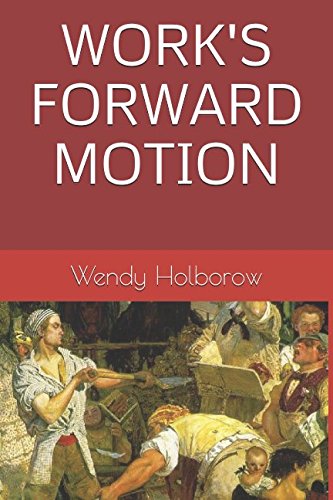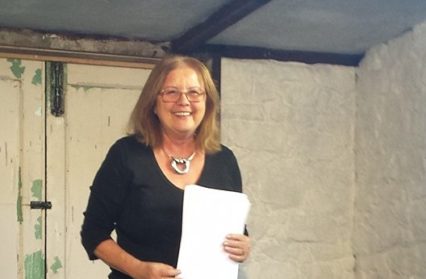Jo Mazelis talks to poet Wendy Holborow about her latest collection, Work’s Forward Motion, which draws upon the work of Ford Madox Brown for inspiration.
Jo Mazelis: Your recent collection of verse ‘Work’s Forward Motion’ focused on the painting ‘Work’ by the artist Ford Madox Brown, is this the first time you’ve used a painting as a source for your poetry?
Wendy Holborow: I’ve collected art for many decades and find paintings and photographs especially inspiring for subject-matter, as jumping-off points – there’s something about an image that appeals to the eye and mind – you can get lost in the contemplation of it. A sonnet for Botticelli’s La Primavera, a sestina for David, are included in my new collection coming out soon from Indigo Dreams ‘An Italian Afternoon.’ I have written a couple of poems about Dali’s paintings and sculptures as a result of going to a Dali exhibition in Florence. I also recently wrote an OuLiPo poem – a lipogram, about the paintings on my walls at home. In this sequence I wrote six poem for six of my favourite paintings leaving each vowel (and y) out in turn for each painting. This is a useful exercise for viewing syntax in a new way and to use vocabulary that one might not have thought of using.
 The painting is astonishingly dense with life and detail, showing work in its many forms and thus across a broad range of gender, class and age, how did you approach this in the poems?
The painting is astonishingly dense with life and detail, showing work in its many forms and thus across a broad range of gender, class and age, how did you approach this in the poems?
I started writing this sequence quite a few years ago in free verse, just jotting down notes from research I had done on Brown and the well-known figures in the painting. Later, I started to look for specific voices for the characters, and the form was dictated by those voices. I was also influenced by Rita Dove’s Sonata Mulattica which imaginatively re-created the life of a nineteenth-century virtuoso violinist through lyric poems, short plays and diary entries. It inspired me to include a short play about the women in Brown’s painting, who I imagined coming together to discuss their lives and predicaments.
Ford Madox Brown is one of the most intriguing artists associated with the Pre-Raphaelite Brotherhood and perhaps the most moral, did you consider writing about some of his other paintings or indeed those by William Holman Hunt like ‘The Awakening Conscience’ for example?
Not yet. But it is quite possible I will do so in the future. This particular collection came about because I had been sent Patricia McCarthy’s book, ‘Rodin’s Shadow’ to review, and was hooked from opening the book and seeing a list of characters: Rodin, Camille Claudette, Gwen John, Debussy, etc. It inspired me to want to write a poetry book using a list of characters and while at a Pre-Raphaelite exhibition in London, I bought the accompanying book which included Ford Madox Brown’s painting ‘Work’. I instantly knew that this was what was to become the subject of my collection of poems with the title: ‘Work’s Forward Motion’, which comes from a line in one of my poems. In ‘Pre-Raphaelites: Victorian Avant Garde’ by Barringer, Rosefield and Smith, Tim Barringer said of the painting: ‘it takes us to the heart of Victorian London – a social panorama, visually and politically radical… The painting had radical implications by placing the working man at the top, rather than at the bottom, of society’s hierarchy’. I believe Brown had a wicked sense of humour. He fenced out the aristocrats as he didn’t believe they had an important role in society. They were thrown into the shadows, irrelevant.
So not only did I love the paining for its visuality but for its political context also. I could see that there was a wealth of characters in the picture and that real lives could be woven for these people who came from all social strata. I found it was possible to animate scenes from the painting and although the actions described are fictional, they are based on likely realities. As I write in the second poem of the collection, ‘Our Painter,’ ‘The tapestry of your painting is the yarn / from which I weave my words, / a struggle for dominance / between your image and my syntax,’ and ending with ‘Your lithic patience, work of ethics / limned – yours and mine in tandem. / I shadow your images / with a translation, an explanation.’
In your book, ‘I Address You: A Collage’ you explore the personal or ‘private’ via a series of addresses, illuminating memory by linking it to time and place, did this idea evolve organically or did you conceive it as a device to both write and link the poems?
The genesis of this collection was an assignment set by Professor John Goodby while I was studying for an MA. The task was to write a collage and I went home thinking ‘I can’t do this’ but returned the following week with over 2000 words. This subsequently received a ‘highly commended’ in the Liquorice Fish competition in 2015. The title of the collage interrogates the’ I’ and the ‘You’: ‘I’ the writer or memoirist, and ‘You’ the reader. It contains every address and place I have lived in through the use of a Mesozoic, which is used as a guide to the collage as each address is numbered. The collage is in a scrambled chronological order as true chronological time might bore the reader with too much sense of simultaneousness, as what I discovered about the world and human nature developed at different times of my life.
The collage is a combination of diagrams and various poetic form, from found poetry and personal letters, haibun, several haiku and prose poetry. The content is loosely based on love and hate. Love for animals permeates the work. Anarchism, anti-war, the Animal Liberation Front all draw from my previous activist background. Interspersed are early childhood memories which leave me baffled by the way I thought in my youth. Also, attraction and repulsion of men, ex-lovers, the notion of love and romance in general. A going away from and returning.
The American poet Sharon Olds has said that, ‘As we get older, we see things in a new light’ do you agree?
Only in the sense that I get frustrated when I am asked to sign petitions or see information on social media about things that I and my friends protested and leafleted about so many years ago. Why did we bother with Greenham Common, CND – nuclear war is still a threat, why spend time in a camp outside Porton Down – testing chemical weapons on animals is still going on, baby seals are still being killed for their fur, whaling continues. I could go on and on, but all these things are still happening and it makes me wonder if these atrocities will always continue, so I get rather saddened and angry by the fact that time hardly seems to have improved things.
If, however, you are referring to my poetry and whether or not it has changed as I have aged, then no, because I didn’t start writing poetry until my mid-forties. A life of earning a living, bringing up two children on my own and caring for thousands of animals due to having had an animal sanctuary, meant no time for writing, even if I’d thought about wanting to do so. And then, when I did start writing, I moved abroad for fourteen years where I felt out of sync with the poetry scene in Britain. Some of my early poems were published in the small presses but I had almost given up writing until I was invited to a poetry masterclass with Carole Ann Duffy and Gillian Clarke in 2005. This kick started my writing again, and my poems began to be published in journals such as Agenda, Poetry Salzburg Review, Poetry Ireland Review and Envoi to name a few. So as far as seeing things in a new light in poetry is concerned, I don’t think age has altered anything. Of course, practically, being retired, means I have a lot more time for writing.
You’ve described yourself as an activist, how much has politics informed your writing practice?
I believe poetry is a force, and I am very disturbed by the atrocities of war and the way the wider world treats children and animals. I think poets have a responsibility to speak up and speak out, yet I write very little about the things that seem to matter the most to me, unfortunately, although there are snippets in the Collage, but I find emotion and anger get in the way of words. I cannot articulate the anger I feel and I don’t think the poems would end on a positive note of hope. I tend to ‘preach’ and therefore I have to put those poems in my box of unpublishable poems. But it is cathartic.
The use of form in poetry is often disputed territory because it demands an application of rules but you have clearly found it rewarding and indeed ‘The Navvies’ which recently won the Pre-Raphaelite Prize 2016 was a series of sonnets. Have you always experimented with form?
Sometimes I have an idea about what form I want to write a poem in and a lot of trial and error takes place until it becomes clear what form the poem should take, but I usually write my first thoughts in free verse until I feel where the poem wants me to take it. A few years ago I read a long poem by Silliman, in which he used only five words per line, I found this helped me to tighten my poetry and is a practice I use today if I think I am being too wordy.
Recently I have been writing more experimentally using a lot of Open Field Poems, some OuLiPo poems, Terza Rima, Mesostics. My forthcoming collection, mentioned above, is an eclectic mix of form and of my experiences in Italy.
As for ‘The Navvies,’ a loose corona of eleven sonnets, I had great fun writing these and looking for unusual rhyming. The series of sonnets stretched and expanded the rules slightly, but I like breaking rules in life and in my writing. They could be loosely described as a crown of sonnets, or sonnet corona, which is a sequence of sonnets, usually addressed to one person, and /or concerned with a single theme. In my version, the last line of each sonnet is the first line of the next and so on until I reach the epilogue which is composed of lines from all the preceding poems. After winning the Pre-Raphaelite prize 2016 for this series of sonnets, I was invited to give a lecture about my collection in Birmingham to the Pre-Raphaelite Society, and as part of the talk, read all the eleven sonnets, for which I was enthusiastically applauded. It was quite a feat.
You have also written plays and short stories how do you see these developing in the future?
Poetry is my greatest passion, but sometimes an idea for a short story emerges. I am currently editing a collection of short stories for publication. My plays tend to come from short stories or even poems I have written, but not always. I do believe in recycling my ideas. The Fluellen Theatre Company have performed one of my plays in the Grand Theatre in Swansea, and hopefully will do more in the future.
For a few years you were involved with setting up and running a magazine in Greece, how did that come about?
Back in 1999, three British women in Corfu invited me to join their weekly get togethers to drink retsina and discuss poetry. Not our own – the great poets. They introduced me to Greek poets I’d never heard of, my favourite becoming Angelos Sikelianos. I introduced them to R S Thomas and other favourites of mine. We had become disillusioned by English poetry of that time so I had the bright idea of bringing out our own magazine – Poetry Greece, which unfortunately ran for only six issues, from 2000 -2002. As much as we tried to keep the magazine going, economic circumstances forced us to cease publication. We met a lot of amazing poets of international stature and had a great fun publishing these magazines. Too much ouzo and revelry come to mind, particularly a lunch with the great translator of Greek poetry, Edmund Healy and brunch with one of Greece’s finest Rembetika singers, Vasilis Lekkas when we commandeered a passing child’s scooter and rode around the plateia.
Having recently discovered Amazon’s print on demand service, I realised that it was a good opportunity to re-issue the journal so that it could reach a much wider readership than we originally had. We believe the magazine is as relevant today as it was then. They are now published in an elegantly produced reprint although the content is exactly the same.
What are you working on now?
Poetry Salzburg published my pamphlet in 2015, ‘After the Silent Phone Call’ which included some of the poetry I had written about Corfu, but there is so much more, so I have been collating and editing a much larger collection about my time spent on the island together with poems I wrote after my first return to the island last year.
I am constantly writing new poems, stories and the occasional play as well as the next in the series of my novels for children.
However, the big thing I’ve been working on is a large collection entitled ‘Realigned Landscapes’. Almost twenty years ago, I visited the town of Ioanina in Northern Greece where I saw the bullet hole that supposedly killed Ali Pasha and learnt about his atrocities, particularly concerning his concubines. I have been researching and scribbling about this for years, but have now written a three part collection. Part one is set in the 1880s and concerns the Greek concubines in Ali Pasha’s harem, how they ended up there etc. Part two skips a hundred years ahead to England in the 1970s and the problems of a ménage de trois. Part three, ten years later, sees the daughter of the philandering man, and the great-great-great-great-great granddaughter of one of the concubines meeting in University and ends with an epilogue in the form of a denouement.
This was a hugely challenging narrative to pull off, but an enjoyable one. It uses various forms again, including diary entries, letters, short plays and a variety of poetic forms. I am looking for a publisher!












